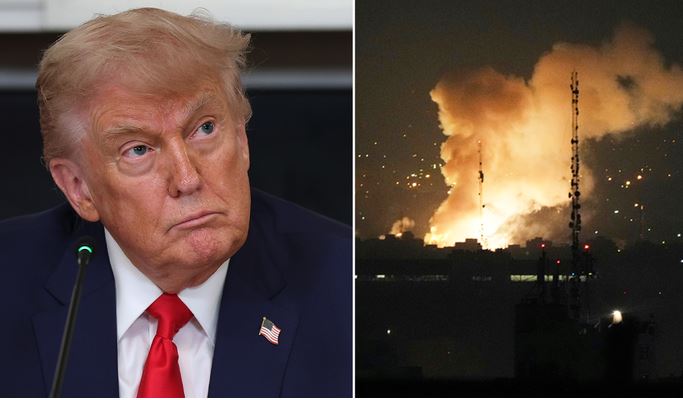Discover how Trump brokered a historic ceasefire between Iran and Israel after a 12-day conflict, reshaping Middle Eastern diplomacy and peace efforts
Introduction
The world held its breath. For twelve agonizing days, the skies above the Middle East had been alight with the fury of conflict. Missiles streaked across ancient lands, and the echoes of explosions resonated globally. The escalating “12-Day War” between Israel and Iran, a conflict long simmering beneath the surface, had finally boiled over, pushing the region to the brink of an unimaginable catastrophe. Cities, including parts of Tehran, saw evacuations, and the specter of a wider regional conflagration loomed large. Then, from the most unexpected of corners, a declaration emerged that stunned the world: Donald J. Trump, the former U.S. President, had brokered a historic ceasefire.
The Spark that Ignited the Inferno

The roots of this bitter conflict were complex and deeply embedded in decades of geopolitical tension. While official narratives pointed to a specific sequence of events, many analysts believed it was an inevitable clash, fueled by diverging national interests and long-standing ideological animosities.
A Deep Dive into the Genesis of Conflict
The immediate catalyst for the 12-Day War was a series of Israeli airstrikes on what it claimed were critical Iranian nuclear and military targets. These strikes, reportedly preemptive and aimed at dismantling Iran’s rapidly advancing nuclear program, tragically resulted in the deaths of several high-ranking Iranian military officials. Tehran swiftly retaliated, launching missile attacks on a U.S. military base in Qatar, citing American complicity in the Israeli aggression. The cycle of escalation was relentless, each strike met with a fiercer counter-response, drawing the two nations into a full-blown, devastating conflict. International efforts at de-escalation seemed futile, and the United Nations Security Council remained gridlocked, paralyzed by deeply entrenched geopolitical divides.
The World on Edge: A Looming Disaster

As the days turned into a relentless procession of conflict, the human cost mounted. Reports of civilian casualties were harrowing, and humanitarian crises began to emerge in affected areas. Beyond the immediate devastation, the global community watched in horror as the conflict threatened to destabilize an already volatile region, with fears of disrupted oil supplies and a severe impact on the global economy.
The Humanitarian Toll and Regional Instability

The images coming out of the war zones were heartbreaking: families displaced, infrastructure shattered, and the innocent caught in the crossfire. Aid organizations struggled to gain access, and basic necessities became scarce. Neighboring countries, already grappling with their own challenges, faced an influx of refugees and the real possibility of being drawn into the vortex of the conflict. The Strait of Hormuz, a critical chokepoint for global oil shipments, became a focal point of international concern, as any disruption there could send shockwaves through world markets.
The Unconventional Diplomat: Trump’s Intervention
Just when all hope seemed lost, a glimmer emerged. While many global leaders had been engaged in traditional diplomatic channels, struggling to make headway, it was Donald Trump, operating outside the conventional diplomatic framework, who seized the initiative. His announcement, first on his Truth Social platform, sent shockwaves across the globe. “It has been fully agreed by and between Israel and Iran that there will be a Complete and Total CEASEFIRE,” Trump declared, attributing the breakthrough to the “Stamina, Courage, and Intelligence” of both nations.

Behind the Scenes: The Raucous Road to Peace
Details of how the deal came together were initially scarce and, at times, contradictory. What was clear was that Trump’s direct, no-holds-barred approach proved surprisingly effective where others had failed. Sources close to the negotiations revealed a multi-pronged effort. While Trump engaged directly with Israeli Prime Minister Benjamin Netanyahu, other senior U.S. officials, including Vice President JD Vance and Secretary of State Marco Rubio, conducted both direct and indirect communications with Iranian representatives. Qatar’s Prime Minister Sheikh Mohammed bin Abdulrahman Al Thani also played a pivotal role, securing Tehran’s agreement through his diplomatic channels.
The negotiation itself was described as intense and fraught with challenges. There were moments when the deal seemed on the verge of collapse, particularly after Iran’s retaliatory strike on the U.S. base. However, Trump’s decision to dismiss the Iranian attack as “very weak” and his public thanking of Iran for “early notice” of the strikes, which he claimed prevented American casualties, seemed to provide a crucial opening for de-escalation. This unorthodox response, coupled with consistent pressure and the clear message that the U.S. was ready to use its leverage, ultimately paved the way for the agreement.
The ceasefire was structured as a phased process, with Iran initiating the cessation of hostilities, followed by Israel 12 hours later, culminating in a “Complete and Total” end to the war within 24 hours. This staggered approach allowed both sides to save face and complete any ongoing missions, a crucial element in securing their cooperation.
A Fragile Peace and the Road Ahead
The world breathed a collective sigh of relief. The ceasefire, though tentative, offered a desperately needed reprieve from the escalating violence. However, questions immediately arose about the long-term implications and the sustainability of this peace. The core issues that fueled the conflict – particularly Iran’s nuclear program and regional proxy conflicts – remained unresolved.
The Unanswered Questions and Future Challenges
While the cessation of active hostilities was a monumental achievement, the path to lasting peace would undoubtedly be long and arduous. International observers noted the absence of concrete terms regarding Iran’s nuclear ambitions, which Israel had cited as the primary reason for its initial strikes. The agreement, brokered rapidly under intense pressure, seemed to prioritize an immediate halt to violence over a comprehensive resolution of underlying grievances.
The coming weeks and months will be critical. The international community will be watching closely to see if the ceasefire holds, and if it can serve as a springboard for more substantive negotiations on disarmament, regional security, and a framework for peaceful coexistence. The “12-Day War” may have ended, but the intricate dance of diplomacy in the Middle East is far from over. Donald Trump’s unconventional role in this historic moment has undoubtedly rewritten the playbook for international peacemaking, leaving the world to ponder the future of diplomacy in an increasingly complex global landscape.
